Join the club
April 1, 2009
One of the aspects of my job on the ship as the orthopedic coordinator is taking care of kids and young adults with club feet. Most of the kids in Africa have what’s called “neglected club foot”, which means that they have had no intervention for their problem, and have walked on club feet for their entire life. The side of the foot isn’t meant to bear weight, and as a result, these kids grow up to have poorly functioning and painful feet, and also have to deal with the social stigma of a very visible deformity. Try to walk on the side of just your heels for a little while and you’ll get an idea of what it might be like to walk around with two club feet.
Surgery for club feet is a common procedure that we do on the ship for a variety of ages, from 9 months to 20 years old. In small children, the surgeon can perform a release of all of the tissues that pull the foot inward, and fix the main problem, but as they get older, the bone grows so abnormally that the surgery involves cutting a large wedge of bone out in order to straighten the foot. The problem with any of the club foot surgeries is that there is a chance of recurrance of the deformity, and although the surgery does make a dramatic improvement, many of the patients will develop pain as they age, because the foot is not completely normal.
These surgeries for club feet are rarely performed in developed countries, because children born with club feet are almost immediately placed in casts for the first few months of their lives, and need little to no surgery after the casting. This specialized casting technique called the Ponseti technique has a 94% success rate, and is considered the standard of care in developed countries, but the trick is that the child must be casted before about 9 months of age. But in Africa, children are born with this problem, and the families don’t have the money or the access to trained orthopedic doctors that can cast the child, and they therefore grow up with this debilitating deformity.
I didn’t think that we’d be able to do any Ponseti castings, because they are not considered a surgical procedure, and each orthopedic surgeon is not here long enough to follow these babies, and make sure that the casting is correct. But soon after we started screening it became apparent that if the physical therapist (Jana) and I could learn how to cast these kids, then we could continue to treat new babies throughout the outreach, even when the surgeons are gone.
But even after a couple of weeks of casting with different surgeons, I still wasn’t sure about the whole thing. I mean, trying to reshape a baby’s foot while they’re screaming, and knowing that you could potentially make them worse rather than better made me a little nervous and unsure about the whole idea. But then last week things started becoming a little bit more clear. One of the surgeons that just came actually trained under Ponseti, and I think the combination of practice and helpful instruction has given me more confidence in the process and my abilities to do it correctly. And then this week, when I went out to call one of the babies and their moms into the clinic, the mom immediately handed her tiny 2 month old to me so that she could carry the rest of her belongings, and standing there holding that baby was all it took. There’s something about these tiny little babies, staring up at you with their beautiful dark brown eyes…I knew that I couldn’t make any more excuses for not being able to cast these kids.
So now, even though I still cringe a little when I see that another baby is coming in for casting, I look forward to being able to be a part of giving them a chance at a normal life, free from the physical and emotional burden of club feet.
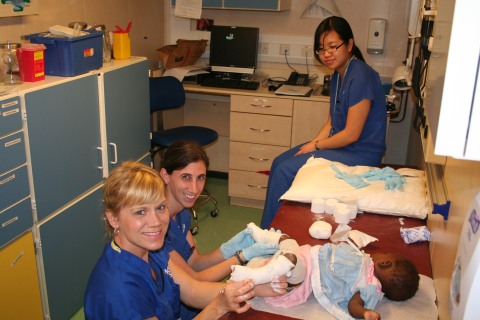
Jana and I doing our first casting
Fajita Fiesta
March 24, 2009
This last Saturday was my friend and fellow Texan, Ashley’s birthday. So we decided to celebrate with a little Mexican fiesta, Africa style. I’ve gotten to be friends with Ashley and Allison, both Texas girls, and we’ve recently started a tradition of Friday night fajitas, complete with fresh guacamole (but no margaritas) since we’ve gotten to Benin.
So this week we decided to make fajitas with our usual group for Ashley’s birthday, and then have chips and salsa and dessert with a larger group, complete with homemade sopapillas, and country western music playing on the top deck of the ship. We had a good turnout, and I got to introduce the wonders of fresh guacamole and sopapillas to East coasters, Dutch, Swiss, and Irish friends. Anytime I can share Tex-Mex in some form or fashion, it makes me happy, so it was a fun evening, filled with eating, chatting, and even a little country western dancing by Ashley and Brandon.
Me, Allison, and my "I am special plate"
Allison, me, Jana, and Ashley at the inaugural fajita night
Test tasting the fried sopapillas with butter, cinnamon, and honey. Mmm
Chatting on the top deck
I’ve gotten used to having my food prepared for me at every meal, and have begun thinking of cooking for myself as a chore. But there is a large crew galley with ovens, pots, pans, and even kitchen aid mixers, so cooking is quite enjoyable. It’s been great to get together and cook with these girls. We’ve decided to make it a regular event, and I have a feeling that birthday celebrations will be fiesta style from now on.
How many people can fit in the back of a truck?
March 21, 2009
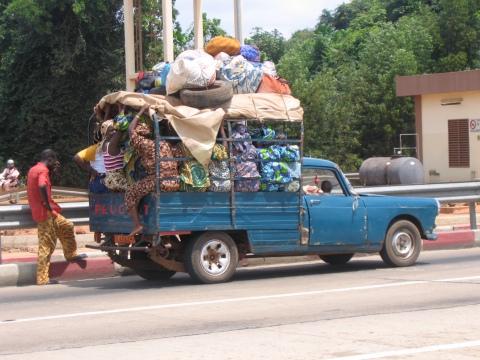
Togo or not to go? Not really a question.
March 17, 2009
This past weekend a group of us ventured over to Togo for a little bit of exploration. Benin is such a skinny country, with the coastline a mere 80 miles long, that the neighboring countries are a tempting place for exploration. So a couple of us were discussing this fact a few weeks back, and decided that we would try to head to Togo first, and see what we could see.
I think most of us just wanted to explore a different place, and get away from the ship for a while, so we picked the most accessible destination, which was the capitol city, Lome. So then the planning began. We had quite a few people wanting to come, but none of us knew the country, or even the language (French), for that matter. So we decided to ask a fellow crew member named Israel, who is from Togo, what he suggested we do. And much to my delight at least, he suggested that he could just come with us…perfect!
He told us up front that there was not much to do in Lome, but that he’d help us get there, and he even knew about a hospitality house where we could stay from the organization, Youth With a Mission (YWAM).
So we got up early Saturday morning, signed our life away (really just our disembarkation papers), and were driven to a taxi agency, where Israel, our newly christened tour guide, had helped arrange an “air conditioned” van for all 14 of us to travel in. Now I’ve seen some of the so called “bush taxis” that you can take to different parts of the country, and was a little concerned about the travel accommodations, but it ended up being a nice, slightly cramped van for the trip.
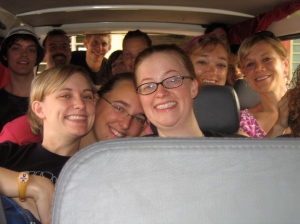
It took us quite a while to get out of Cotonou, as there are almost 4 million people that live in and around the city (think trying to leave Houston without using highways or continually paved roads), but once we did get out, it was nice to drive through the countryside, away from the smogginess of the city. Four hours and 80 miles later, we arrived in Lome, and were taken to the YWAM house located in a quieter area outside of the main city.
Once we got there, a YWAM staff member had prepared lunch for us, which was a nice surprise. So while waiting for lunch, we explored the surrounding area, and two from our group, Jana and Kevin, decided to check out the business next door to us with a sign that said ”Massage/Gym”. They went in and found a lady very willing to give as many of us massages as she could, so 4 of us signed up for a massage later that evening.
After a great lunch we decided to go to the big marketplace, which is always an experience in these countries. As soon as all 14 of us showed up, we were immediately surrounded by vendors speaking their five English phrases that they knew. We wanted to split up, but couldn’t, because no one knew where we were except for Israel. So we stayed together, attracting lots of attention, and not really getting any shopping done. A few of the girls in the group were able to buy some great, colorful fabrics to make African skirts and dresses.
On our way through the market we also picked up a few persistent vendors who ended up following us for the next half hour as we walked to the beach. Yovo’s (white people) are obviously hot commodity’s around the market, and these guys weren’t ready to give up their sale without a fight. They finally went on their way after a while, and we were left to sit by the beach and enjoy the view.
Many of the beaches in this area of Africa are used either for bathroom facilities, or as places to live. So we were pleasantly surprised to find a fairly normal looking beach near the market place, and as it was late in the afternoon, it was cool and enjoyable to sit, talk, and watch the waves.
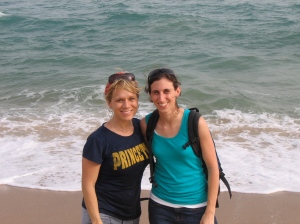
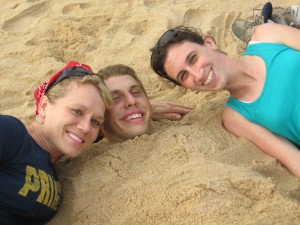
After a while we decided to go grab dinner at a Lebanese restaurant that had been recommended to us. We walked in and were immediately greeted by the owner, who was delighted to have such a large group at his restaurant. We had a great dinner, and stayed a while to listed to the live jazz band that was playing.
But eventually we had to leave, because some of us had massages to get to (it’s such a rough life here in Africa). So we showed up to the massage place and I got my first massage ever in Lome, Togo, for 5 bucks. Not too bad, especially for someone like me who always likes a deal. The lady who ran the place ended up talking half of our group in to getting a massage, and she stayed until almost midnight for all of us. I’m quite sure we made her week.
We went back to the two houses we were staying in only to discover that the nice breeze that was present earlier in the day had ceased, and left us with very warm houses. My roommate Jana and I laughed at each other as we spread out on the beds in anatomical position, trying to cool off somehow. It didn’t work to say the least, and it made me very grateful for the ship air conditioning.
Sunday we got up and went to Israel’s church, which is a huge church- over a thousand people. It was nice to be in a big church, worshipping with so many people. The funny thing is that the speaker that week was a pastor from Bismark, North Dakota, who was in the country for a construction mission trip. A group of men from his church came up and did an acappella performance for the church, and the congregation absolutely loved it. I think they thought it was funny to have grown men singing so many different pitches, from low to high.
We finished church, and had another home cooked meal at the YWAM house, and then headed home. I wasn’t really expecting much from the weekend, other than getting to see another country, but I had a very good time just being away from the ship, and staying in a real house. We all had a good time getting to know each other more, and just enjoying whatever the next activity happened to be.
Now that we’re back, it’s time to start planning the next trip. This time I’m hoping it’s one that will lead us on a safari in northern Benin…
Beauty for ashes
March 11, 2009
I was on call for the hospital this past weekend, and one of my jobs while I’m on call is to admit all of the patients on Sunday who are coming in for surgery Monday morning. I wasn’t really looking forward this task for numerous reasons, one being that it was new to me, and therefore a little stressful, and also just the fact that I was going to be working on Sunday. So I started out the day slightly begrudgingly, but then I began to see patients, and things changed. Since being here, I’ve seen numerous patients, but they all have had orthopedic problems. On Sunday I was able to see the full range of patients that we serve on the ship, including people with facial tumors covering much of their face, children with cleft palates, and patients experiencing the effects of preventable diseases such as noma and polio.
But it wasn’t the things I saw on Sunday that effected me the most, rather it was the stories I heard from a specific group of women. Earlier in the weekend we had received a group of about 20 women with vesiculovaginal fistulas (VVF), and I was able to admit a group of them for surgery on Monday morning.
VVF is a condition that effects an untold number of women in the developing world. Without access to proper medical care, the women will spend days in prolonged labor before giving birth to a child that has died during the process. In many of these women, the stillborn baby is just the beginning of their suffering, because during the prolonged labor, the large amount of pressure to the birth canal results in a hole or fistula that forms between the bladder and vaginal canal and this is called a vesiculovaginal fistula. This fistula causes them to be completely incontinent of urine and sometimes feces as well. As you can imagine, it is impossible for these women to lead a normal life, with the constant leak and odor of urine following them around, always reminding them and everyone around them of their condition. In many of these countries, the worth of women is bound up in their ability to bear children and to be useful as a wife, so many have also been rejected by their husbands and families, who want nothing to do with them.
I’ve been told about these ladies, and have read about what their problems were, but actually meeting them made things much more real to me, especially since most of them are my age or younger. The first woman I met was a tiny, 19 year old from so far north that none of our interpreters even spoke her language. I began to ask her story, and she told me (through another VVF lady and then my interpreter) that she had been in labor for many days, went to the hospital, had a cesarean section, delivered a dead child, and then developed VVF. Here was a girl much younger than I, that had been through a terrible childbirth, lost her child, and now has a devastating condition, all because of lack of access to medical care. I didn’t even know what to say to her, except that I was so sorry for her loss. Each patient I saw had the same story- a long labor, death of the child, and then the leaking began.
The good news for these women is that we have a surgeon that can perform a surgery to repair the fistula. So as I heard each woman’s story, I was able to offer a bit of hope, as we prepared them for a surgery that can truly give them their life back. After the women have had their surgery, and have recovered, they are given a new dress and headdress in a celebratory ceremony, signifying the beginning of a new life for them. It is a touching time that I’ve already been able to witness here on the ship.
I didn’t really expect to be moved so much by seeing patients on a Sunday afternoon, but Iwas. It’s a beautiful thing to be a part of work like this. And it’s here that I feel we can be the people of God and be the ones to “bind up the brokenhearted..give beauty for ashes..and a garment of praise instead of a spirit of despair” (Isaiah 61).
**I don’t think I could ever completely explain this condition and the devastating effects that it has. So if you want to learn more about VVF, the documentary “A Walk to Beautiful” chronicles the lives of 5 women in Ethiopia with VVF, and is supposed to be excellent.**
Screening Day(s)
March 4, 2009
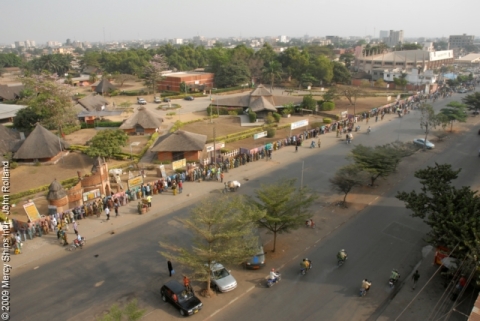
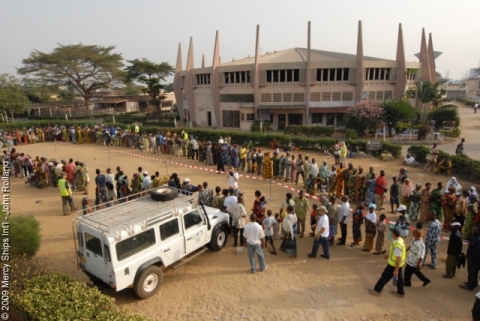 After a lot of preparation and briefings, screening day ended up arriving a day early for us in the orthopedic department.
After a lot of preparation and briefings, screening day ended up arriving a day early for us in the orthopedic department.
We started on Wednesday the 18th with a “small” early screening that was set up by the local social services department for pediatric orthopedic patients. We showed up to the local office and found at least 75 children and quite a few adults already lined up and ready for us to screen them for orthopedic problems as well as facial tumors and many other maladies. We hurriedly set up and started the slow process of seeing patients and trying to graciously turn away those non-orthopedic problems. As the day went on, more people showed up, and I think we ended up seeing well over 100 kids with orthopedic issues, and we only had 2 surgeons.
One of the first set of patients that we saw were a set of twins with bowed legs. They are a little girl and boy, and their names differ only by an inflection over one letter, which of course only adds to how cute they are. They’re about 4 years old, and we decided that we would be able to help them both, so we scheduled them for surgery the during the first week. For some reason bowing of the legs seems to be a common orthopedic problem in this area of the country, and we have seen it over and over during our screenings. Although these kids can get around without many problems right now, the bowing will cause them much pain and disability as they get older. In the US they would be put in braces at a very young age, and would probably have early surgeries if needed. But in Benin, they don’t get any early intervention, and as a result, there were many children that we saw who had such severe deformities that we were not able to help them out. Here are some pictures of the kids we saw. As you can see they had no trouble having fun and running around. 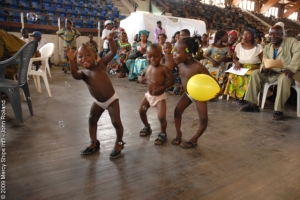
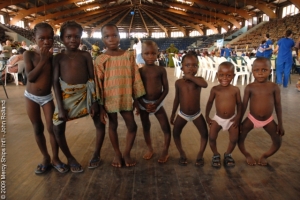
Wednesday was a long, hot day as we were working outside. There were so many kids to see that we didn’t want to take a break. We were able to spend a good amount of time with each child and their parents, which we were not able to do at the big screening, and were able to explain to them their problems whether we could help or not. We saw many bowed legs or knocked knees, clubbed feet, congenital deformities, old broken bones, frozen knee joints, and many many children with some form of cerebral palsy.
The children with cerebral palsy were definitely the hardest for me. I could see the hope in the family’s eyes as they carried their child to us, thinking that we could fix their arms and legs so that they could walk and be normal. It was difficult to tell them that there was no surgery that could be done to “fix” them. What amazed me most though, was their reaction. At first their face would fall, and they would try to make sure they had understood us. Then they would pick up their child, smile, and simply say thank you.
I don’t know why that picture is so powerful to me. Maybe it’s because I felt so helpless in telling them there was nothing to be done. I like to be able to fix things, and I was powerless to help them, yet the people still thanked me. It’s a good reminder to me that I can’t do everything on my own, and while we may not be able physically heal everyone, we are here to be a blessing to all that we come in contact with. That may mean giving someone a life changing surgery, or doing something as simple as listening to them and acknowledging what they are going through.
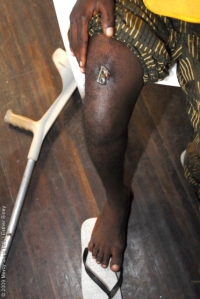
Screening day video
February 23, 2009
Here is a video that was put on YouTube about screening day. I was told it was a good video- I can’t actually stream video from the ship, so I hope it works for you all. Tell me if it doesn’t, and maybe I’ll be able to find it somewhere else.
First dose of African fast food
February 21, 2009
Well, this week has been a little crazy as we prepared for and then screened over a thousand patients with medical needs. It was exciting and exhausting at the same time. I’ll write more about it soon, but I want to wait until I get photos- I just don’t think words can do it justice. So here’s a post that I started this week and finally finished…
Last Saturday I determined that I was going to go out and have my first African meal of the year. I had carefully consulted the Benin guide book and found that there was a good, reputable African restaurant right outside of the port called Marquis du Port. I decided I should stick with a recommended location for the first meal, in anticipation that my stomach may not handle much more than that, and carefully mapped out the directions and plans for the evening.
I convinced my friend Emily to come with me to this new place, and I felt good about my plan as we headed out. We walked confidently out of the port, and easily found the restaurant, but as we walked up to the door, Emily stated that she had seen a group of Mercy Shippers eating at the restaurant (or should I say roadside stand) next door. I wasn’t sure about this change of plans, but I agreed that the stand certainly looked more interesting so off we went.
We walked up and sat down, hoping that that was what we were supposed to do. We were immediately approached by a man and woman who apparently owned the stand next door, and they began to try and persuade us that we should get up and come over to their place. After a few “No, merci’s” they left us alone and the person belonging to our restaurant came to take our order. Emily, being Canadian and knowing a little more French than me, asked what we could eat. The lady quickly replied that they had “no more food”. Now, I’m not really sure if that meant we were too early for dinner, or they only serve drinks after a certain time, or that they really were out of food. Whatever the case, we looked at eachother and decided to get up and try another place.
The place next door was also only selling drinks, so that was out, and by this time I thought my original restaurant choice might be the best solution. But as we walked by Marquis du Port it somehow looked quite boring after seeing the roadside stand possibilities. So we set out to find a new place that actually served dinner. After walking a few blocks, we spotted a place where we were pretty sure people were eating, and cautiously walked up and asked if we could sit and eat. They of course said yes, and welcomed us in to their restaurant.
I don’t have a picture, but it was a small open air place with a kitchen and about 5 tables. They did have a TV under the awning that was playing loud music videos of some sort- definitely adding to the atmosphere of the place. We asked about the food, and the server tried to tell us, and then just gave up and pointed to someone else’s plate. Apparently there was one dish of the evening, so we ordered two of the one and only special, hoping for the best.
It didn’t take long to get our order out to us, and it was at point I realized that I was probably getting my first version of African fast food. Not a bad thing, just notquite what I was expecting. We both decided that we need a picture of the food, so here it is. 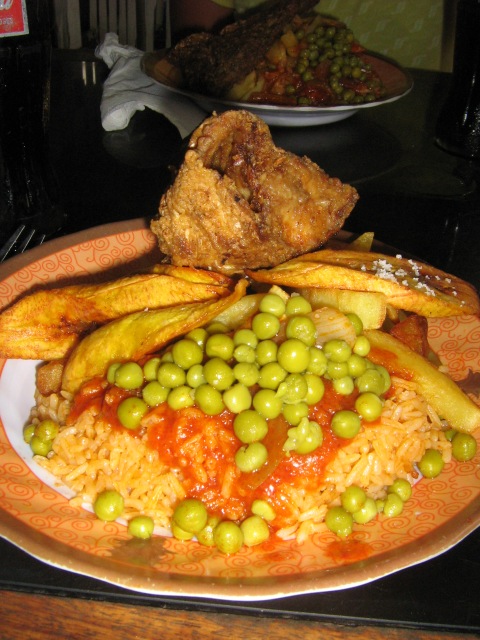 The majority of the dish was something fried- fried whole fish (no head though), fried plantains, french fries, and rice and peas. It was a good meal, and the best part about it was that I didn’t get sick!
The majority of the dish was something fried- fried whole fish (no head though), fried plantains, french fries, and rice and peas. It was a good meal, and the best part about it was that I didn’t get sick!
Neither of us could actually finish our whole plate, so the waiter cleared our plates and promtly threw the leftovers in a plastic bag and gave it to the man that was begging about 3 feet away from us. I have to admit that up until that point, I had been sort of trying to ignore the man, but when your leftovers get placed in his hands, it’s hard to not think about him. I began to think I should have just bought him dinner instead of letting him eat my picked over food. I don’t know if that would be an answer that I could duplicate every time I eat, but I know it reminded me that I am in an area of intense need everywhere I turn here.
Sometimes seeing the needs is overwhelming, and the easiest thing to do is to go back to the comforts of the ship, and not think about the fact that me spending three dollars on a meal I can’t even finish is a luxury. That’s easy to do wherever I live, but I know the Lord has called me as a follower of Jesus to somehow be a reflection of him to those around me, wherever I am. That calling is much more tangible for me here, and I pray as I spend the next months in Benin that I would not choose to bury my head in the sand, but would instead be able to live out Christ’s love in tangible ways as I meet people and take care of patients.
Make your best constipation face..
February 16, 2009
Yes, this is what we told the crew as they exited the recovery room that was doubling as a walk-through digestive system on Friday night. After cleaning and setting up the ward and operating rooms all week, the nurses put together an open house, full of different activities for the kids and adults on board.
Many of the crew will not see the hospital portion of the ship once the it’s up and running, so this is a chance to show the those who work in other areas of the ship what we do in the hospital.
The wards were set up for different activities, which included blood pressure screening, ultrasounds by the ward physician, teaching knitting for adopt-a-patient activities, and even a section of “difficult” patients played very well by some of the nursing staff. The kids were given tasks to perform with the patients, such as giving medicines (M&M’s) or changing bandages. It was highly entertaining to watch.
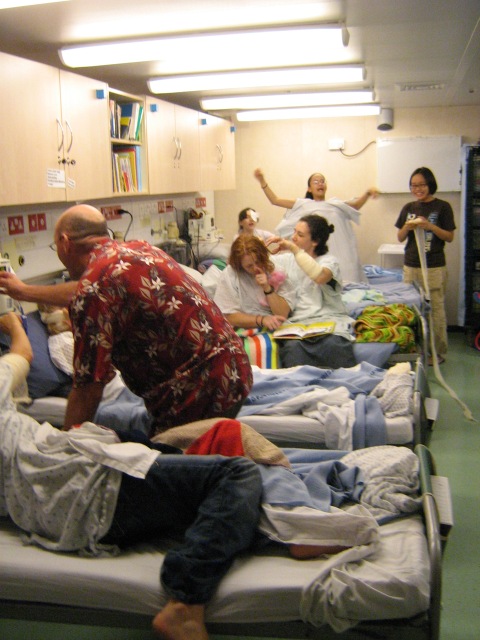
In my room we had made up an interactive journey through the digestive system, that started with the tongue (aka: a slide), and ended, well, where the digestive system ends. As the crew exited the large intestines and were leaving the room, someone had the grand idea of giving out tootsie rolls and asking for the participant’s best constipation face. It was interesting to watch the different reactions from kids and adults alike, as they understood what we were saying.
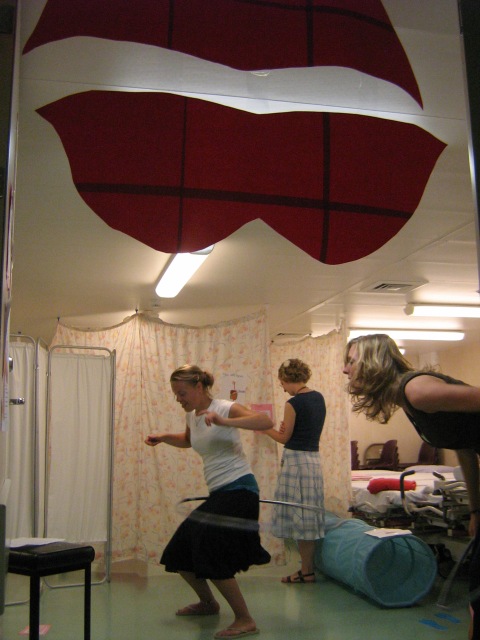
The operating rooms also set up different sections which included learning how to intubate, suture, and a table where you could dress up like a surgeon and “operate”. Some of the kids really got in to operating, and did a number on the stuffed animal that was acting as the patient.

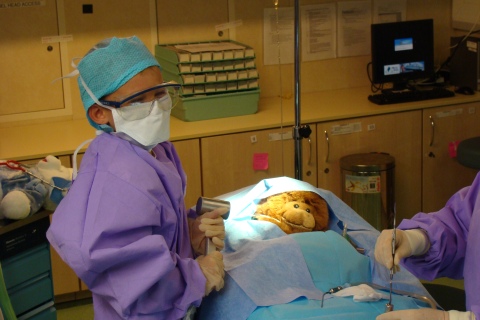
It was a fun evening, and I think it helped those that don’t work in the hospital to feel more connected with what’s going on in the ministry of the hospital. I can imagine that it can be discouraging to work somewhere other than the hospital, and not be able see much of the ministry that you are working for. So I am glad that we had this opportunity to laugh and share with everyone a little bit of what goes on in the hospital. Now if only treating patients was as easy as giving them M&M’s….
Zemidjans and yovo’s
February 13, 2009
After getting cleared by the port authorities, we were able to set foot on dry land on Wednesday in Cotonou, Benin. A group of us went walking through town right after work, and tried to get a feel of the city that we will be calling home for the next few months.
We are docked about ¼ mile away from the port entrance, and we pass a fisherman’s market as we walk out of the port. 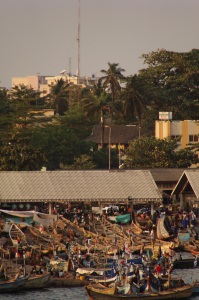
The boats are all very colorful and packed tightly as can be seen. We don’t actually walk through the fish market where the boats are docked, but I’m sure I’ll make a trip over there soon so that I can experience the sights AND smells of a large fish market.
Once we walked out of the port, we were immediately greeted by a blur of zemidjans speeding by, and the kids calling out “yovo” (translation: whitey/foreigner) to us. A zemidjan is a moped or motorcyle that acts as a taxi in Cotonou. It’s estimated that there are around 80,000 zemidjans in Cotonou alone, and I’m pretty sure all of them view traffic signals/laws as merely suggestions. So if you want to go somewhere, you flag down a zemidjan, hop on the back, and pray that you live to see your destination. Needless to say, Mercy Ships strongly suggests NOT riding on one of these. I am not planning on riding on one ever, but I’m sure I’ll have some interesting stories to tell about them in the future.
Once we braved crossing the side street, we walked up one of the main thoroughfares and just looked around for a while. The city is very busy and crowded, and traffic is chaotic and completely unpredictable. We found a fresh vegetable market about 10 minutes from the port, and had fun walking through and chatting with the vendors. Well, maybe I should be more clear, the two girls that spoke French chatted, I just said “bonsoir” to everyone.
As I we walked, I began comparing this city with my experiences in other foreign cities, and realized that I had some expectations already formed in my mind. I was expecting the sounds and smells and general confusion of being in a new place and culture. I think the amount of traffic going in all directions was a little overwhelming and more than I had originally thought.
The people and kids that we crossed paths with were friendly and warm to us, and that was encouraging to me. It makes me look forward to getting know my patients and their families as we begin screening and surgeries in the next week. For now, we’re still working hard to try and get everything ready for screening and the hospital opening, so we’ll see how it all comes together.